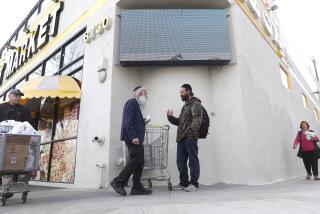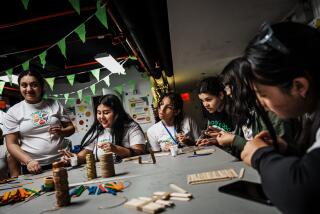Students of the World : Ethiopian Israeli Students at High School Cultural Exchange Program Tell of Flight to Freedom
- Share via
SANTA ANA — For one, there was a great trek through the desert before reaching the promised land. For the other, it was a journey by water.
By a strange circumstance, the two high school students--one born in Ethiopia, the other in Vietnam--shared their tales of escape, survival and rescue in a Santa Ana high school Wednesday morning.
The Ethiopian, a Jew, is an Israeli now, and the Vietnamese is an American.
“We had the same struggle,” said Tri Nguyen, 16, a junior at Valley High School, who survived weeks in the open sea and Thai refugee camps to come to America in 1982. “We are just from different parts of the world.”
Added Oshra Yosef, 17, whose family endured a long march through the Sudan desert on foot and months at a Sudanese refugee camp before being airlifted to Israel: “I found we share the same problems. We are in the same boat.”
Yosef is one of two Ethiopian Jews participating in a cultural exchange program, “Children of the Dream,” with three Santa Ana high schools for the next two weeks. Sponsored by the Anti-Defamation League of B’nai B’rith, the 3-year-old program is meant to challenge racial and religious stereotypes.
Yosef and Aviel Avraham, 18, were among the thousands of Ethiopian Jews who fled civil unrest and religious persecution in their native land in the early 1980s. Commonly known as falashas, a derogatory term in their language meaning “stranger,” they were airlifted from Sudanese refugee camps to Israel in 1984.
Ethiopian Jews are believed to be descendants of one of the lost tribes of Israel, having lived for centuries in isolated mountain villages. Though cut off from the Jewish mainstream, they observed many Jewish customs, including kosher dietary laws and circumcision.
On Wednesday, the two Israeli students began a two-day process of sharing their harrowing and joyful migration with students at Valley High School. Today, the local students, who are predominantly Latino and Vietnamese, will tell of their own difficulties blending into a different culture.
The two Israelis will also participate in similar exchanges at Century and Saddleback high schools before they return to the Middle East on April 9. In October, three Orange County students will complete the exchange program by visiting Israel.
Yosef told the American students about her family’s wanderings in the desert by foot, donkey and mule. The ordeal claimed the lives of two of her nephews. “On the way, many people got sick and some died,” Yosef said.
The sadly familiar story resonated with Stephanie Tran, 16, who lost an older brother she no longer remembers during her family’s desperate journey to America. Tran, an honors student who arrived in America in 1981, doesn’t even know the circumstances of her sibling’s death.
“Nobody at home really talks about it,” she said quietly.
Valley High students studied Jewish history and customs for a week prior to the visit. The existence of black Jews surprised many students.
“It’s a weird concept,” said Wesley Oliver, 17, an African American who met the Israeli students in an advanced placement U.S. history course Wednesday. “I knew there were black Jews like Sammy Davis Jr., but I didn’t realize there were Jews in Africa.”
The Ethiopian’s arduous path to freedom altered the teen-ager’s perspective on his relatively uneventful life in Santa Ana.
Perhaps because of their past strife, the Ethiopian refugees’ newfound sense of national identity contrasted sharply with their American counterparts. The African-born students, who say racism is nonexistent in their new home, identified themselves with certainty as Israeli.
The students, almost all of whom were American born, found the task more problematic, labeling themselves mostly by their forebears’ land of national origin.
“I don’t know what I would say my nationality is. I was born in Compton and so were my parents,” said Venita Hebert, 16, who now lives in Santa Ana. “Mexicans who were born here say they are Mexican. Japanese who were born here say they are Japanese. So, I’m an African, who was born in America.”
After the class, Yosef reflected on Hebert’s remark.
“She’s proud to be an African and I’m glad,” said the outgoing Israeli student, who has mastered three languages and wants to be a lawyer someday. “But she is also an American. She lives here and so does her family. She has to be able to say that.”
The students did more than grapple with the weighty issues of race and religion. History teacher Carol Wade’s fourth-period class was transformed into a multicultural “American Bandstand” of sorts.
Students of Samoan-Hawaiian and Mexican background cranked up music popular in their cultures for their visitors. The American students even drafted the reluctant Israelis into dancing to different drummers.
“It was embarrassing for me at first,” said Sivaiana Sio, 17, a normally shy student who performed a Tahitian dance for the class. “But I wanted to share my culture with them, since they are sharing theirs with me.”
More to Read
Sign up for Essential California
The most important California stories and recommendations in your inbox every morning.
You may occasionally receive promotional content from the Los Angeles Times.










